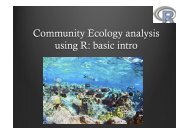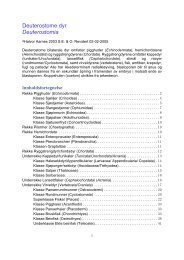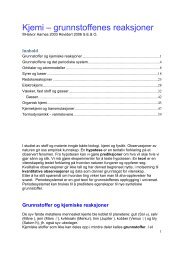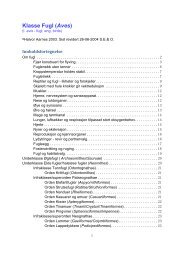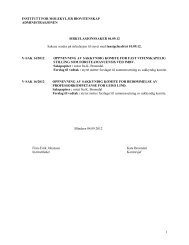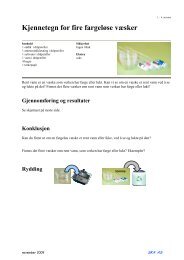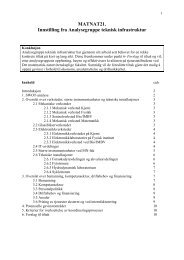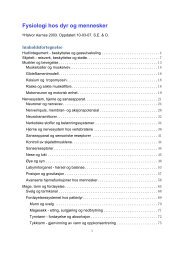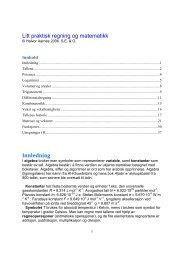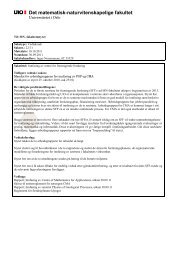7 How to Set-up DHIS2 in a New Context?
7 How to Set-up DHIS2 in a New Context?
7 How to Set-up DHIS2 in a New Context?
Create successful ePaper yourself
Turn your PDF publications into a flip-book with our unique Google optimized e-Paper software.
204Integrated Health Information Architecture: Power <strong>to</strong> the UsersThe core <strong>DHIS2</strong> platform developers: The global team who are develop<strong>in</strong>g the softwareconstitut<strong>in</strong>g the platform <strong>in</strong> close <strong>in</strong>teraction with the use context through the <strong>DHIS2</strong>implementers and designers. They are develop<strong>in</strong>g the <strong>in</strong>novations that are shaped astechnical artifacts.The <strong>DHIS2</strong> implementers and designers: These are the facilita<strong>to</strong>rs and developers of the<strong>DHIS2</strong> <strong>in</strong>stances that are be<strong>in</strong>g implemented <strong>in</strong> countries. They are work<strong>in</strong>g <strong>in</strong> closecooperation with users, and they are mediat<strong>in</strong>g ideas and requirements for newfunctionalities and feedback on the software between the users and the developers.They are the <strong>in</strong>novation media<strong>to</strong>rs between users and core developers. They are also<strong>in</strong>nova<strong>to</strong>rs <strong>in</strong> terms of develop<strong>in</strong>g new ways of apply<strong>in</strong>g and us<strong>in</strong>g <strong>in</strong>formation.Potential and actual users of the range of <strong>in</strong>formation and services: These provided bythe <strong>DHIS2</strong> are many, and they are rang<strong>in</strong>g from the <strong>in</strong>dividual users <strong>in</strong> the field <strong>to</strong> thehealth managers at district and higher levels, policy makers, <strong>in</strong>ternational organisation,<strong>to</strong> the general public. This is the both the context and driver of <strong>in</strong>novations. Innovationsare generated <strong>in</strong> direct <strong>in</strong>teraction with the <strong>DHIS2</strong> platform, result<strong>in</strong>g <strong>in</strong> its furtherreconfiguration, extension and development. Key <strong>in</strong>novations are l<strong>in</strong>ked <strong>to</strong> new waysof do<strong>in</strong>g th<strong>in</strong>gs with the help of technology.Third party developers: These are target<strong>in</strong>g actual and potential users and use cases asa market for their particular <strong>in</strong>novations, which may take shape as new modules orplug-<strong>in</strong>s, but also as new configurations of the platform, without new add-ons.Educational schemes, tra<strong>in</strong><strong>in</strong>g and universities: Make <strong>up</strong> the <strong>in</strong>stitutional glue, whichenables <strong>in</strong>novations <strong>to</strong> actually materialise through the cycles of use-ideas forimprovements-trial-workable module or work practice. While ‘learn<strong>in</strong>g through use’ asa first step <strong>in</strong> a process of <strong>in</strong>novation and ‘conceptualis<strong>in</strong>g new ways of do<strong>in</strong>g th<strong>in</strong>gs’as the second, the follow<strong>in</strong>g steps of br<strong>in</strong>g<strong>in</strong>g ideas all the way <strong>to</strong> technologies andimplementations will require a range of skills where universities and wider tra<strong>in</strong><strong>in</strong>gschemes are key components. Masters and PhD programmes and now also the <strong>DHIS2</strong>academy have been important build<strong>in</strong>g blocks <strong>in</strong> the <strong>in</strong>novative DHIS processes s<strong>in</strong>cethe start <strong>in</strong> the 1990’s.Figure 7.13 provides an overview of the <strong>DHIS2</strong> <strong>in</strong>novation ecosystem.A key challenge <strong>in</strong> the <strong>DHIS2</strong> <strong>in</strong>novation ecosystem is <strong>to</strong> establish ways for local<strong>in</strong>novations <strong>to</strong> be spread globally by be<strong>in</strong>g made part of the global core, or by be<strong>in</strong>gcompatible with the generic <strong>in</strong>terfaces <strong>to</strong> the <strong>DHIS2</strong> core. In the previous chapter, wehave discussed the complicated process <strong>to</strong> organise distributed development anddeployment <strong>in</strong> such a way that all the country specific branches and versions of the<strong>DHIS2</strong> are compatible with the ‘core’, that is us<strong>in</strong>g the generic <strong>in</strong>terfaces. This is needed<strong>in</strong> order <strong>to</strong> ensure that local <strong>in</strong>novations are becom<strong>in</strong>g part of the global core andthereby are shared by all nodes <strong>in</strong> the system. Innovations may become part of thecore through simple <strong>in</strong>clusion, <strong>in</strong> the cases where the module is developed as be<strong>in</strong>gcompatible with both the global core code base (us<strong>in</strong>g standard <strong>in</strong>terfaces) and the<strong>DHIS2</strong> cod<strong>in</strong>g standards. If this is not the case, the essence of the local <strong>in</strong>novationwill be <strong>in</strong>cluded through redevelopment, as was the case with the Indian Dashboard.Ideally, therefore, the more synchronised the local module development is with theglobal core development, the better, that is, the less resources it takes <strong>to</strong> make it par<strong>to</strong>f the global core.




